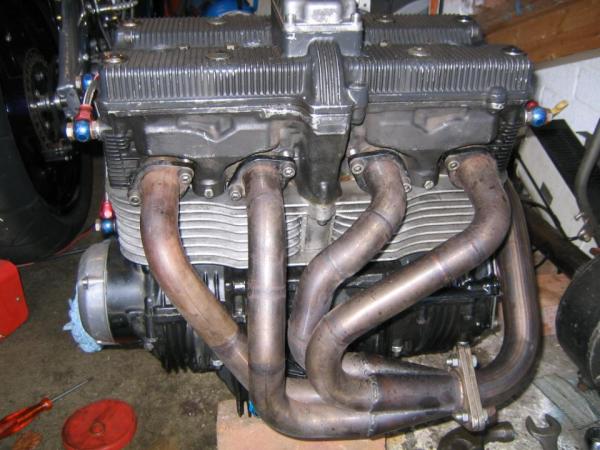-
Posts
5,758 -
Joined
-
Last visited
Content Type
Profiles
Forums
Events
Everything posted by Gixer1460
-
The 5 degrees or so fitted angle will not make a huge difference in fuel levels - you've followed the book, thats good enough!
-
Off bike float valve checking really needs to approximate fitted conditions in bike (sorry if obvious!) Carbs to be set at intake angle and with a 'decent' quantity of fuel in a remote tank / header / can / bucket / whatever, needs to be connected to the inlets and be positioned about 2 -3 feet above the carbs. Yes, its higher than when fitted, but a little excess is better. A good float valve/s should hold against this head of fuel at least for 6hrs to be called good!
-
That's a question I don't think i've ever seen asked on OSS before! Probably because most people don't find it critical. I assume you are talking fitted height? which would be influenced by seat cutting / valve recession? My manual isn't exactly forthcoming in valve spring info other than free lengths, no tolerance, wear limit, poundage etc! So would assume if they are about the correct length 'free', whatever they are fitted, is mint! Just don't recess the valves too much as that affects seat spring pressure but also compression ratio!
-
LOL's - just imagine how much clearance was required with a +5mm stroke in my 'M' engine! Oh, and HAVING to swap out shims for screw adjust rockers is BS! They spit shims if they are over rev'd - riders kill engines not design 'flaws'
-
Assuming std coils then age takes its toll - not unusual for coils to start to fail once they get warm / hot. Swap out for a known good coil first. Ign. boxes a) won't be common, b) unlikely to be cheap and c) will be the same age as yours that might have failed so how long may it live? Swapping to an aftermarket ign. may be the cheapest / more reliable solution. PS - old bikes with faults are cheap for a reason LOL!
-
Or in your case, a large hole and a small hole and a butterfly shaft . . . . . . 'not all carbs are created equal' Glasshopper!
-
That's what the soft coating on a MLS gasket does, and does it better as it won't bake away! Keep grease for paper and fibre gaskets - to help with disassembly.
-
Personally i'd put the lanyard pull inbetween the bar risers, then if the rider does bail, the pull on the cord is equal either way. As fitted if bailed left it could be trying to pull almost perpendicular to the plug - i've seen snapped cable before plug disconnected ! And although it is something else electrical, power all the bike electrics via a big single or multiple relays that are all earthed via the lanyard - they aren't the most reliable things or have capacity for lots of amps, so grounding a relay or 2's coils is a lot safer. Love the loom organiser ! Oh, and what's it going to cost ? . . . . . . . . . How fast would Sir like to go LOL!
-
All of the GSXR type engines had D dowels, changed from the tube type used in the GSX family. If you can afford it a Cometic gasket set is worth paying for but get OEM oil drain tube O rings - use nothing else! Any of the decent tuners / engine builders should be able to source quality gaskets.
-
Yes! ! ! Now its Turbo time ! No Excuses or you're a pussy!
-
They usually are but it makes no difference providing they are drawn for anti clockwise rotation - as that one is! Using the Ign. side has advantage of a smaller bolt and mostly able to use the rotor integral nut to turn the crank, the LHS risks the nut undoing whilst turning - righty tighty, lefty loosey LOL!
-
Maybe i'm deaf (dumb fool! You are! - in one ear LOL!) but just sounds like a Bindit cos I hear nothing odd!
-
Common enough mod and I find studs an nuts a damn sight easier to assemble compared to a cap head bolt int o a hole you can bearly see! SS studs and bradd or copper nuts is a safe solution IMO.
-
Never seen anyone use grease for a headgasket but can't imagine any reason not to use it, nor that it will cause problems! As it is less compressible than a normal sealant, thick grease 'could' stop full clamping force being applied but a thin smear - don't sweat it!
-
Against the whole mass of the clutch, that little piece missing will make knob all difference! Holding tools such as this type are best used with two pairs of hands - as you now know!
-
You might be able to lift the barrels just enough to slip the tensioner seats into position - its awkward but saves the chance of a busted ring or two! As for fitting pistons - get 2&3 atdc, slip barrels on sitting on top rings and gently ease rings into barrels with thin screwdriver & fingers. Gavity works for you as will push barrels down on to next ring set. Once 2&3 are done, rotate crank whilst moving barrels with pistons till 1&4 slot in and repeat although space is V limited! Enjoy!
-
That was mentioned earlier !
-
I wondered what they were ? ? ? As I couldn't read the side bar numbers they were meaningless - below the bottom line just looked like regular AF trace!
-
Yes, it can be done but isn't just 'bolt on'. Will gain power due to better flow characteristics but there are cheaper and easier ways!
-
From what I can make out on that AFR trace (which isn't much!) the engine is rich at top and bottom and lean to ok in the midrange! Smaller numbers means rich! Can't see what any of the output numbers are but nice curves - not earth shattering looks stock!
-
They may do as stock - so do the shimmed 'GSXR heads! But a ported head of any type should address the limitations to pretty much flow as good as they can, whatever the initial flavour!
-
If cold, its likely oil drag but it shouldn't be silly rpm's, if hot, then yes draggy clutch! If its adjusted correctly then its probably clutch plate / basket wear. These old monsters are a little clunky on gear selection / location of neutral - most get used to it after a while!
-

Heavy duty parts for short stroke 750?
Gixer1460 replied to IhmeJanneFIN's topic in Forced Induction
Hey - back off! Don't quote rules that don't apply! Apart from a reference on a youtube title I see no mention of the word Katana to describe this bike on this site! -
Better above static oil level as scavenaged oil will be aerated - not good mixing that into sump oil even if it does degas relatively quickly!



